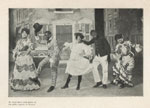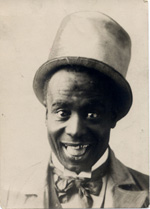The New York
Public Library for the Performing Arts > Vaudeville
Nation
Tab Shows

In Dahomey cake-walk from
left
Hattie McIntosh, George
Walker, Aida Overton Walker,
Bert
Williams, Lottie Williams,
from The Playgoer

Promotional photograph of S. H.
Dudley in street clothes and
in character costume.

Ernest Hogan in costume
as "The Oyster Man"
Although most acts were independent, vaudeville also absorbed
the late 19th century tradition of "Combinations," "Tabs," or
other short musical shows, led by a vocalist or comic. Vaudeville
supported many such troupes of African American performers. The
first to become widely popular were led by opera singers
Sisserietta Jones, known as "Black Patti" (after Italian
soprano Adelina Patti), and the Hyer Sisters Emma and Matilda.
In the late 1890s, 1900s and 1910s, popular companies were
led by rival comics Ernest Hogan, known as "The Oyster Man," S.
H. Dudley, with his Smart Set Company, The Whitman Sisters,
and the team of George Walker and Bert Williams. Their troupes,
which combined and re-combined often, included most of the
important vaudeville and musical talents of the era. In
addition, the musical comedies of Will Marion Cook and of
Bob Cole, James Weldon Johnson and J. Rosamund Johnson toured
in tab versions, as well as the full-length work. They performed
in New York City vaudeville and on Broadway, but in most
American theaters, there were separate circuits and theaters
that, like their communities, followed segregation policies. The
troupes often toured on the circuit of smaller theaters in
the Theater Owners Booking Association, known colloquially
as TOBY, or "Tough on Black Acts."
Another form of tab shows that emerged often during vaudeville
were developed by producers, who used them to try out talent
and material. Dance director Ned Wayburn presented such
acts in the 1900s for the Keith Circuit and again in the
1920s for the Headline Vaudeville Production Company. Like
Wayburn's Broadway shows for Lew Fields and Florenz Ziegfeld,
Jr., they were known for their precision line dancing, lighting
effects, multiple set changes, and similar technical marvels.
Related Images